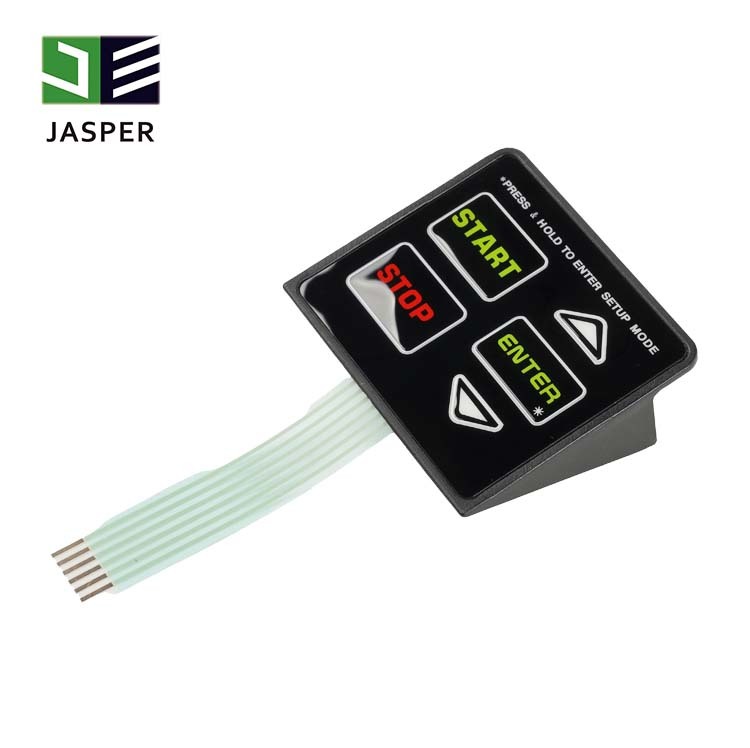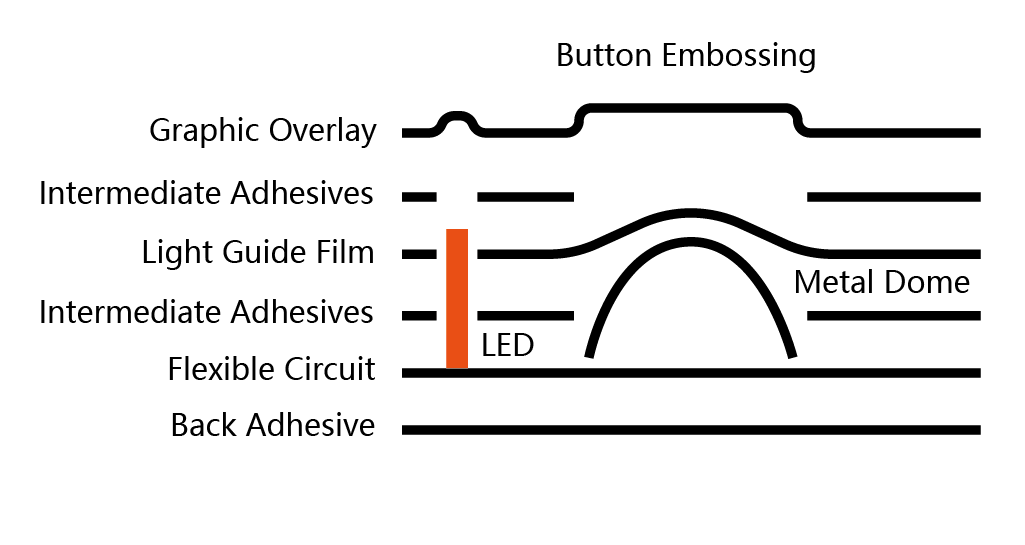Top considerations when choosing a membrane switch for aerospace use
Wiki Article
The Production Process Behind Membrane Layer Switch: What You Required to Know
The production procedure behind membrane layer switches over combines careful layout, product selection, and top quality control. It begins with understanding the ins and outs of membrane button style and progresses via numerous stages, consisting of product options and printing methods. Each stage plays a necessary function in ensuring performance and resilience. Nonetheless, the intricacies of layer building and construction and the strenuous testing standards may reveal insights that are not right away evident. What lies beyond these foundational components?Understanding Membrane Layer Switch Over Style
Although membrane buttons may appear basic in the beginning look, their design includes detailed factors to consider that guarantee functionality and durability. The style process begins with a comprehensive understanding of individual requirements, consisting of the interface's desired application and environmental elements. Comfort designs is a vital element, as the format should help with convenience of usage while making sure that responsive responses meets customer expectations.Moreover, the layering of parts, such as visuals overlays, adhesive layers, and conductive traces, should be specifically engineered. membrane switch. This split configuration not just influences the switch's responsiveness yet additionally affects its long life. Focus is provided to the securing methods employed to secure versus wetness and dirt, which can jeopardize performance. Additionally, style factors to consider expand to aesthetic appeals, where color design and aesthetic quality boost individual experience. Ultimately, the style of membrane layer switches over equilibriums performance, customer experience, and sturdiness, making sure that they meet the demands of different applications effectivelyProducts Used in Membrane Layer Change Production
When selecting products for membrane layer button manufacturing, it is vital to contemplate both performance and sturdiness. The key products include polyester and polycarbonate films, which give versatility and toughness. These movies are typically coated with glue to assure proper bonding to substratums. Conductive inks, typically composed of silver or carbon, are critical for creating electric links within the button, permitting for reputable operation.Additionally, a safety layer, such as a difficult layer, is often put on enhance scratch resistance and long life. The selection of backing product, such as acrylic or foam, can substantially affect the button's responsive feeling and general user experience. Moreover, various environmental variables, including temperature level and moisture, should assist material option to ensure peak efficiency in certain applications. Ultimately, the best mix of materials adds to the membrane switch's functionality and life-span, making informed selections crucial for manufacturers.The Printing Process: Creating Video and Text
The printing process in membrane switch production plays a substantial role in producing high-quality graphics and text. Various visuals design strategies are employed to guarantee aesthetic allure and performance, while cautious ink option approaches are important for resilience and efficiency. Recognizing these components is essential for achieving finest lead to membrane button design.Graphic Style Techniques
Graphic layout methods play a crucial role in the printing process of membrane layer switches, as they specify exactly how graphics and text will inevitably appear on the end product. Effective graphic style entails the tactical use font styles, colors, and designs to boost readability and aesthetic appeal. Designers frequently use vector graphics for scalability, making sure that photos continue to be sharp at different sizes. Furthermore, interest to contrast and placement is essential, as it affects customer communication and visual top quality. The incorporation of branding aspects, such as logo designs, must be managed with care to maintain brand name stability. Overall, thoughtful visuals design methods contribute significantly to the capability and appearance of membrane layer switches, influencing customer experience and item efficiency.Ink Selection Techniques
Choosing the proper ink is important for attaining the wanted aesthetic quality and toughness in membrane switch production. Different ink types are used, consisting of solvent-based, water-based, and UV-curable inks. Each type offers distinctive qualities, such as adhesion, flexibility, and resistance to environmental variables. Solvent-based inks are frequently favored for their resilience and lively colors, while water-based inks are a lot more environmentally friendly however may have restrictions in bond. UV-curable inks provide quick healing and robust efficiency. Additionally, shade matching methods guarantee that the selected inks line up with design specifications. Ultimately, the choice of ink must think about aspects such as application approach, substratum compatibility, and end-use requirements to attain superior outcomes in membrane button graphics and message.Layer Building And Construction and Setting Up

Material Selection Process
A careful selection of materials is vital in the manufacturing process of membrane layer buttons, as it straight influences functionality and toughness. The main materials made use of consist of polyester, polycarbonate, and different conductive inks. Polyester is commonly favored for its outstanding resistance to chemicals and abrasion, making it suitable for rough settings. Polycarbonate, on the other hand, offers superior quality and effect resistance, which is advantageous for applications requiring visibility and toughness. Conductive inks, usually made up of silver or carbon, are vital for developing reputable electrical paths. Additionally, the selection of glue materials influences the general honesty of the switch - membrane switch. Reviewing elements such as ecological exposure, responsive comments, and aesthetic requirements overviews manufacturers in choosing the best materials for their specific applicationsLayer Bond Strategies
Sticking layers in membrane button construction is an essential procedure that ensures performance and longevity. Different bond techniques are used to protect optimal bonding between layers, which commonly consist of using adhesives, warmth, and pressure. Pressure-sensitive adhesives (PSAs) are frequently utilized for their convenience of application and instant bonding capacities. Furthermore, thermal bonding techniques can be used, where heat is utilized to activate sticky homes, securing a solid bond. The look these up choice of bond approach mostly relies on the materials entailed and the specific application demands of the membrane switch. Correct alignment and consistent application of adhesives are essential to stop defects, protecting the button runs efficiently throughout its desired lifespan.High Quality Control Actions
Guaranteeing high quality control throughout the layer construction and assembly of membrane buttons is essential for preserving efficiency and integrity. This procedure generally includes numerous critical steps, consisting of detailed inspections at each stage of production. Makers make use of innovative testing methods, such as peel tests and adhesion evaluations, to confirm the stability of layer bonds. In addition, aesthetic examinations are conducted to identify any defects in printing or material disparities. Environmental conditions, such as temperature and humidity, are carefully kept track of to guarantee perfect treating and adhesion. Normal calibration of devices assists maintain precise manufacturing criteria. By applying these quality assurance procedures, makers can considerably decrease the risk of item failing, ensuring that the final membrane layer switches over satisfy the required specifications and consumer assumptions.Evaluating and Quality Control Actions

Developments in Membrane Switch Over Innovation
As advancements in modern technology remain to evolve, membrane layer switches are taking advantage of ingenious developments that boost their performance and user experience. One remarkable development is the integration of capacitive touch modern technology, which allows for even more responsive and instinctive individual interfaces. This change not only boosts looks but likewise reduces mechanical damage, extending the life expectancy of the switches.Additionally, advancements in visuals overlay products have brought about improved toughness and resistance to environmental aspects such as dampness and UV light. These materials currently offer improved quality and brightness, additional boosting the visual appeal.Furthermore, the consolidation of clever technology is transforming membrane layer switches over into interactive control panels, making it possible for connection with IoT devices. This connectivity cultivates a smooth user experience, paving the method Continued for applications in numerous industries, from health care to customer electronic devices. Jointly, these innovations setting membrane layer switches over as critical components in contemporary gadget style.Regularly Asked Inquiries
How much time Does the Membrane Change Manufacturing Process Take?
The period of the membrane layer button production procedure can differ substantially. Variables such as intricacy, products used, and manufacturing quantity impact timelines, with typical production varying from a couple of days to numerous weeks for conclusion.What Are the Usual Applications for Membrane Layer Buttons?
Membrane layer buttons are generally made use of in numerous sectors, consisting of vehicle controls, family home appliances, medical gadgets, and consumer electronics (membrane switch). Their versatility and resilience make them perfect for applications requiring user-friendly user interfaces and trusted efficiency in varied atmospheresCan Membrane Switches Over Be Custom-made for Certain Requirements?

What Is the Life-span of a Typical Membrane Change?
The life-span of a regular membrane switch varies, however usually, it varies from 1 to 5 million cycles. Variables such as usage, environment, and material quality significantly influence toughness and total efficiency with time.

Are Membrane Changes Eco-friendly?
The environmental kindness of membrane layer changes varies. Some materials used might not be recyclable, while others can be green. The general effect depends on manufacturing materials and practices, demanding cautious consideration during option and disposal. The production process behind membrane layer changes combines careful layout, product choice, and quality control. It starts with comprehending the intricacies of membrane layer switch design and proceeds with various phases, including product options and printing techniques. When picking materials for membrane layer switch production, it is necessary to consider both efficiency and toughness. A cautious option of materials is essential in the production process of membrane layer switches, as it directly affects performance and durability. The option of adhesion technique largely depends on the products involved and the certain application requirements of the membrane layer button.Report this wiki page